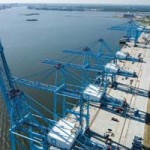 By Peter Galuszka
By Peter Galuszka
Is there something fishy about Gov. Robert F. McDonnell’s push to privatize the Virginia Port Authority?
For months, state Transportation Secretary Sean Connaughton, privatization-minded corporate executives and some consulting firms have been beating a drum about the supposedly bad if not fatal fiscal outlook for the VPA and Virginia International Terminals, a semi-private entity beholden to the VPA that runs operations.
They’ve also been saying that Virginia’s port executives have been off the ball on dealing with a drop in cargo during the recession compared to competing ports such as New York and Savannah. To press the point, McDonnell jettisoned most of the VPA board not long ago.
Now comes a report by the watchdog Joint Legislative and Review Commission, the General Assembly’s version of the federal GAO, that much of the nay-saying just isn’t true. The report was released Friday as was news that 2012 was the second-best year in cargo volume for Virginia ports.
If this is true, then McDonnell and Connaughton have some explaining to do. It seems they are very enthusiastic about the idea that a private corporation could run the port better than a quasi-public outfit. This follows an unsolicited offer by APM a giant Dutch shipping conglomerate with some operations in Hampton Roads to run the VPA for 48 years.
Connaughton, who had claimed that the VPA’S operating structure was “financially unsustainable,” has fired back saying that JLARC is in a conflict of interest because it based its upbeat report on the health of the VPA on the work of a consultant, John Vickerman of Williamsburg, who had just finished a report for the VIT.
The JLARC report has some powerful nuggets:
- “The Virginia Port Authority’s market performance and outlook appear to be more positive than suggested by a recent report when additional relevant factors are considered.”
- “The Virginia Port Authority does not appear to be financially unsustainable, as a recent report suggested. The authority is positioned to generate a net profit during the next five years, particularly given the projected growth in cargo volume during the period.
- “Administrative expenses could be reduced by eliminating duplicative administrative functions shared by the Virginia Port Authority and Virginia International Terminals.
- “Virginia International Terminals and Virginia Port Authority executives are compensated at levels higher than most other port authority executives in the United States.”
This is hardly the picture the McDonnell administration and APM want to paint. Just two months, Jim Bacon interviewed top APM officials and wrote:
“For starters, Virginia International Terminals is bleeding cash. With operating revenue of $94 million, VIT pays $50 million in debt service, $38 million in rent for APM Terminals and $35 million in operating costs. The operating loss will amount to $29 million and $25 million in FY 2013. The financial picture gets increasingly bleak through 2030 when the APM lease expires. Says (APM executive John Crowley): When the lease expires, $1.2 in projected future cash flows will disappear’.”
Or maybe it isn’t so bad. Legislators have said they are understandably confused.
If the VPA people are doing a good job after all, they seem to be well paid for it. JLARC says they are among the highest-compensated port officials in the country. Joe Dorto, VIT president and CEO, made $754,330 for the fiscal year including a $192,335 bonus. Former VPA executive director Jerry Bridges made $418,250, the third highest of any port authority executive at his level in the country, according to a survey.
Now in its last year, the McDonnell Administration has been pushing hard on the privatization concept on on several fronts, notably highway construction. But before the VPA is signed away in yet another privatization scheme, Virginians deserve to know the facts behind the VPA.


